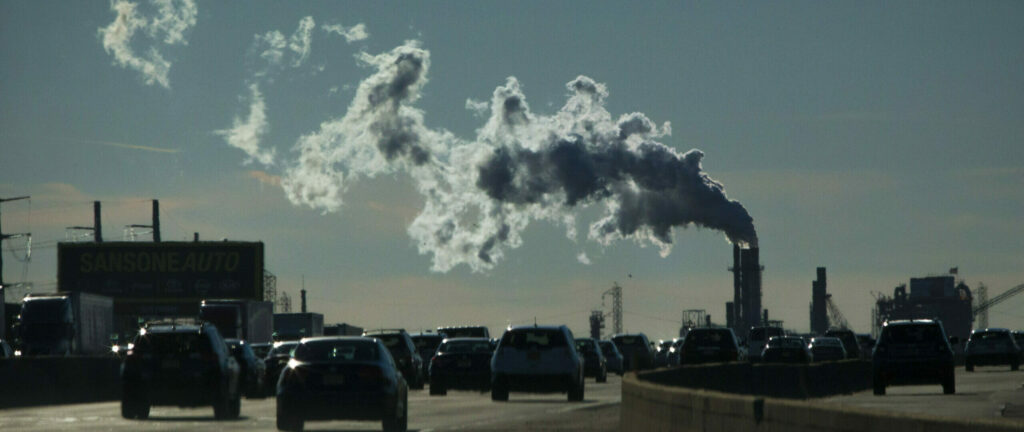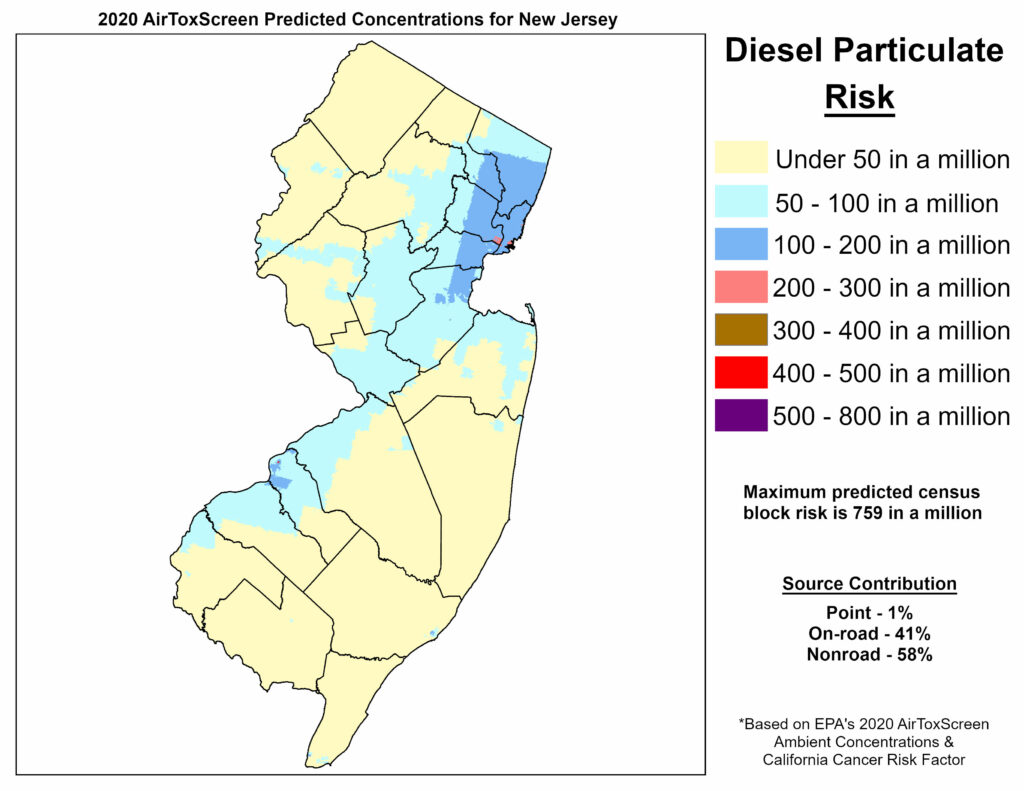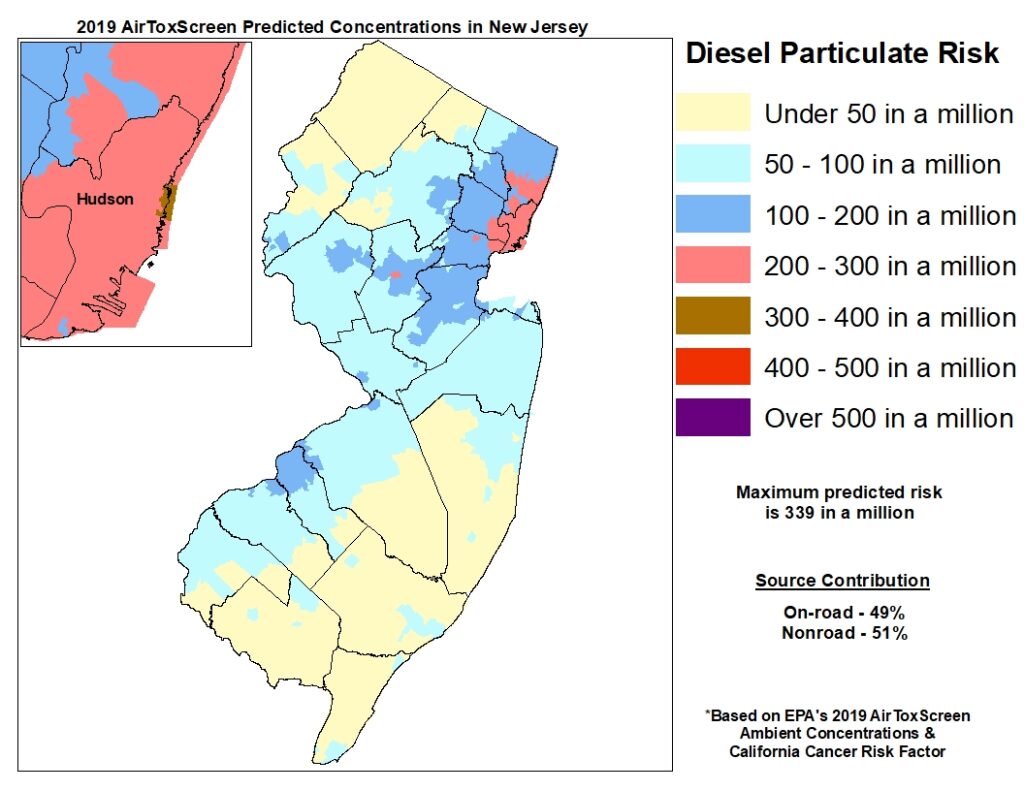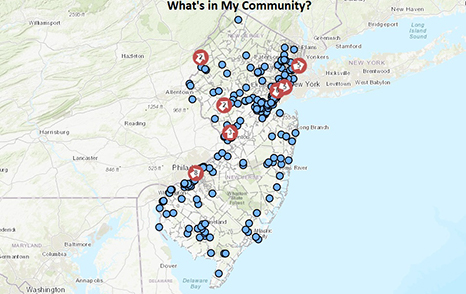Exposure to air toxics is a widespread problem that occurs throughout the entire state.
These pollutants come from a variety of sources, including traditional industrial and utility sources, smaller manufacturing and commercial sources, mobile sources (such as diesel trucks, cars and buses), construction equipment and residential activities (such as oil burning for home heating or using gas-powered lawn equipment). Air pollutants can be broken down into two Categories: Criteria Pollutants and Air Toxics.

Air Toxics & Criteria Pollutants - What's the Difference?
There are six pollutants for which the USEPA has set National Ambient Air Quality Standards (NAAQS). These are known as Criteria pollutants. They are ozone, sulfur dioxide, carbon monoxide, nitrogen dioxide, particulate matter, and lead. For many years, they have been addressed throughout the country through a standard planning process, and the concentrations of these pollutants in the air have been extensively monitored and tracked for compliance with the air quality standards. The standards are established by the U.S. Environmental Protection Agency (USEPA), and monitoring is carried out by state, local and tribal governments to determine whether the standards are being met.

Sources of Air Toxics
Any other air pollutants that are not criteria pollutants (except Lead, which is both a criteria pollutant and an air toxic), and that may be emitted into the air in quantities that can cause adverse health effects, can be classified as Air Toxics. These health effects cover a wide range of conditions from lung irritation to birth defects to cancer. There are no National Ambient Air Quality Standards (NAAQS) for these pollutants, but in 1990 the U.S. Congress directed the USEPA to begin to address a list of almost 200 of these air toxics by developing control technology standards. These particular air toxics are known as, Hazardous Air Pollutants (HAPs).

2020 Air Toxics Assessment for New Jersey
Exposure to air toxics is a widespread problem that occurs throughout the entire state. These pollutants come from a variety of sources. NJDEP uses USEPA’s AirToxScreen to evaluate the types and amounts of air toxics people are exposed to all over New Jersey.

New Jersey's Approach to Addressing Air Toxics Emissions
In 1979 NJDEP specifically addressed exposure to air toxics, when N.J.A.C.7:27-17, “Control and Prohibition of Air Pollution by Toxic Substances” was adopted. This regulation listed eleven “Toxic Volatile Organic Substances” (TVOS) and required that sources emitting those TVOS into the air register with the NJDEP, and demonstrate that they were using state-of-the-art controls to limit their emissions.
In the past, USEPA compiled a National-scale Air Toxics Assessment (NATA) that estimated exposure for about 140 air toxics (hazardous air pollutants, or “HAPs”) throughout the country. The assessment has been done for 1996, 1999, 2002, 2005, 2011, and 2014. For the 2017 NATA, EPA changed the name to Air Toxics Screening Assessment, or AirToxScreen. AirToxScreen is conducted annually, and is accompanied by a mapping tool. Beginning in 2020, AirToxScreen data is analyzed at the census block level. In the past, risk was modeled at the census tract level. Both NATA and AirToxScreen follow the four-step process described in the tabs above. For more detailed information, go to USEPA’s website for the AirToxScreen Assessment.
The emission inventory quantifies the type and amount of emissions of HAPs from a wide variety of sources. USEPA divides the emission sources into six categories:
Point (large manufacturing facilities, utilities, etc.)
Nonpoint/area (small industrial facilities, dry cleaners, residential fuel combustion, consumer product use, etc.)
On-road mobile (cars, trucks and buses)
Nonroad mobile (trains, cargo ships, construction equipment, agricultural vehicles, etc.).
Fires (wildfires, prescribed fires and agricultural burning)
Biogenic (plants, trees and soil microbes)
AirToxScreen also includes air toxics concentration estimates from:
Background Concentrations (toxics from distant sources, pollutants from previous years that are still in the environment, natural sources not included with biogenic emissions)
Secondary Formation (toxics formed through chemical reactions between pollutants in the air)
USEPA compiles this information into the National Emissions Inventory (NEI) every three years and then extracts and modifies it for input into dispersion models (see item 2).
To predict how pollutants from the sources in the emissions inventory would move through the air and be distributed throughout the country, USEPA uses computer-based tools to feed emissions information into dispersion models. For AirToxScreen, USEPA uses AERMOD to model emissions from point, on-road and nonroad mobile sources. The Community Multiscale Air Quality (CMAQ) model was also used to estimate ambient air concentrations and to estimate the secondary formation concentrations of acetaldehyde, acrolein, 1,3 – butadiene and formaldehyde. For the air toxics modeled in both the AERMOD and CMAQ models, USEPA uses a special hybrid modeling method, which combines the annual concentration results from both models to compute ambient concentrations.
For AirToxScreen, USEPA takes an extra step to adjust the predicted air concentrations to account for activity patterns and demography, thus making exposure a composite of different concentrations experienced in various places throughout the year. This process uses HAPEM7, a screening-level inhalation exposure model. The result is an average “exposure concentration” of a pollutant that people at the state, county or census block level are estimated to breathe. It can be either higher or lower than the ambient concentration for the corresponding area.
In this last step of the AirToxScreen, EPA calculates cancer risk and non-cancer hazard index by pollutant. To do so, EPA combines the census block level exposure concentration estimates (generated in the previous step) with available unit risk estimates and inhalation reference concentrations for each pollutant.
- USEPA states that although AirToxScreen is not designed to characterize risks sufficiently for regulatory action, it expects that the results can help to:
- Identify air toxics of greatest potential concern.
- Characterize the relative contributions to air toxics concentrations and population exposures of different types of sources (e.g. major, mobile) that emit air toxics.
- Set priorities for the collection of additional air toxics data and research to improve estimates of air toxics concentrations and their potential public health impacts.
- Track trends over time in modeled ambient concentrations of toxics.
- Measure progress toward meeting goals for risk reduction from inhalation of ambient air toxics.
How We Estimate Risk from Air Toxics
Government agencies, such as USEPA and the California Office of Environmental Health Hazard Assessment (OEHHA), have established procedures for developing human toxicity values from chemical studies in order to determine a “safe” level of human exposure. Groups of experts look at all of the available health effects studies done on a chemical, and refine the information into a dose-response value that can be used to estimate the risk to public health from exposure to that chemical. These toxicity values are referred to as unit risk factors and reference concentrations.
Health Effects of Smoke from Fire
EPA collects emissions data from wild land fire sources for the annual AirToxScreen. These emissions include smoke from wildfires, prescribed burns, and agricultural fires. Although fires are a minor contributor to the HAPs analyzed in AirToxScreen, fire events generate pollution that has short-term, noncancer health impacts.
Predicted Levels Compared to Monitored Data
NJDEP measures outdoor concentrations of air toxics at four monitoring sites in New Jersey. They are located in Camden, Elizabeth, New Brunswick, and Chester.
Federal Air Toxics Program
Under the federal Clean Air Act Amendments of 1990, USEPA is required to adopt a number of national air toxic reduction programs that currently address 188 hazardous air pollutants, also known as HAPs. NJDEP works with USEPA to implement these programs in our state. Two of these programs are the adoption of Maximum Achievable Control Technology (MACT) standards for large sources (such as chemical manufacturing), and the Urban Air Toxics Strategy for small sources (such as hospital sterilizers). Once USEPA has issued all of the MACT standards, they are required to conduct a health risk assessment and revise a standard if it is shown to be necessary to protect public health.

What's in My Community?
Interactive mapping tool to help residents identify sources of air pollution in and around their community. On the map you’ll find every facility with an air permit registered with the Division of Air Quality at the New Jersey Department of Environmental Protection.

Diesel Emissions
The major sources of diesel PM are on-road and off-road vehicles powered by diesel engines. In addition to trucks, cars, and buses, diesel engines are used in construction vehicles, agricultural equipment, trains, and marine vessels. Diesel engines are also used to generate electricity on both an emergency and routine basis.

What You Can Do
Since such a large amount of the toxics we’re exposed to in air comes from motor vehicles, solvents (such as cleaning fluids), power plants, combustion sources (including residential heating), almost everybody can help reduce the emissions of air toxics.